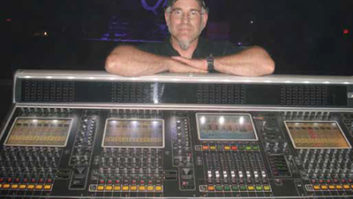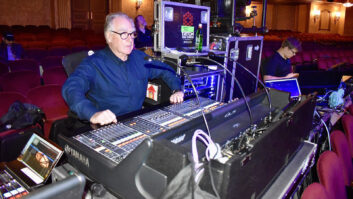Enjoying the calm before the storm, FOH engineer Bradley Johnson prepares for another night of Megadeth at the Hammerstein Ballroom in New York City. There are some bands whose names seem to be tailored to their musical style. Megadeth is one of those bands. With pummeling drums, thrash guitar and guttural vocals, the group has solidified its place in the pantheon of Metal Gods. And it’s up to Bradley Johnson, FOH Engineer, to keep it sounding as viscous as ever. Preparing for the band’s show at Hammerstein Ballroom on its recent Gigantour package tour, Johnson was as mellow as one can get when working for a band that tends to go through engineers like a machine gun goes through bullets. “I still consider myself the new guy,” said Johnson, “but that was four monitor guys ago.”

Gigantour, Megadeth’s occasional travelling festival package, was tackled with crew, stacks, racks and support act control gear from Maryland Sound International (Baltimore, MD), while the headliner’s FOH and monitor rigs were courtesy of Johnson’s company, KRF Audio, based in Newport, WA. At the center of the FOH area was a DiGiCo D5 console. “I was fortunate enough to work for Aerosmith back in the day, and we did a shootout with a bunch of the new desks in a nice anechoic chamber with multitracks coming back, and we could switch between boards,” said Johnson. “This was when digital was in its infancy, and we could listen and hear the tonal differences of the desks without any bells and whistles. The D5 won over some pretty steep competition, and I’ve been using it ever since.”
Advising never to leave home without an Empirical Labs Distressor, Johnson further supplemented his console with Lexicon PCM81s and 91s, a TC Electronic System 6000, and a Waves MaxxBCL. “I don’t use anything onboard the desk—as far as effects go, it’s all external,” he said. “I do multitrack every show just for archives and for virtual sound checks, which is very handy.”
MSI provided the tour with a sizable JBL VTX line array system, based around VTX V25s with MSI BB 21 Subs, as well as JBL 4892s and VRX- 932As for fills. “We’re using MSI’s proprietary sub, which is a 21-inch. It’s kind of contrary to what you might think; it almost sounds like a 15—very tight and very quick, which isn’t what you would assume from a 21-inch speaker. The subs are very good. When we go into an arena, we’ll have four columns for outfills, but here at the Hammerstein Ballroom, it’s just left and right.”
On stage, the band used drums internally miked with Shure Beta 56s and 91s inside the kicks, a Beta 57 on the tom, and AKG c214s for overheads; all the drum mics were mounted using a Kelly Shu system. The guitar amps were (Megadeth frontman) Dave Mustaine Signature Series Marshall 4×12 cabinets, which weren’t miked, as Johnson explained: “There aren’t any microphones on any of the guitars. We’re using Radial JDXs to get the guitar tones; it’s really helpful when you have a detuned guitar, which can get really waffly. Sometimes a microphone doesn’t work really well, and also with our set, we have video walls in front of the backline. There’s only a foot of space between the cabinets and the back of the video wall, so a microphone picks up a lot of residual weirdness and it gets phase-y sounding. So we got rid of the mics altogether….The actual amplifiers themselves are Fractal Audio Systems Preamps, and then that’s going into a tube amplifier that amplifies it into the 4×12. So there isn’t necessarily an amp head.”
When mixing the band, Johnson focuses on working around Mustaine’s distinct vocal style. “Dave’s vocal style is really based in his throat; gain before feedback is the name of the game,” said Johnson. “My mix is really based around the vocal mic; I’m limited to how much gain I can get out of him, and the mix has to be built around that. It’s very tricky to introduce the kind of energy the people expect at a metal show and still get a vocal on top of the mix. There’s a lot of featuring or cues happening during the show where a part is going to get really loud and it’s going to come down when he’s singing a verse. It’s a very busy mix.”
Understandably, Johnson mixed the band using macros: “I use a lot of macros, continuously. The difference is with a macro on the DiGiCo board, I can assign one button to do a hundred things. So if I go to my guitar macros and hit “normal,” that will set up my guitars in a normal situation. I can hit hard pan and it takes my guitars and splits both of them hard pan. For a solo, it pans it stereo and brings up the effect.”
And while many bands this far into their careers just turn up for the show, Megadeth soundchecks before every show—twice. “Dave is amazingly meticulous and methodical about soundchecks,” said Johnson. “He’ll come in and will do the exact same songs, in the exact same order, every single day. He’ll come out without ears in, and he’ll listen to the stage. He’ll listen to the drums, then he’ll listen to the bass, then the guitar player, then he’ll add himself and then he’ll listen to the whole blend onstage. He’ll make adjustments to make it a good-sounding stage mix, which is really helpful to me. Once he’s happy with the levels on the deck, he’ll put his ears in, and then he’ll do the same process again: same songs, same lineup…And because he always does this, you know what (as FOH and monitor) you’re looking for, and what he’s going to do.” The monitors were mixed on a DiGiCo SD8. On stage, the band was entirely in ears—half JH Audio JH16s, half Ultimate Ears UE13— with only a thumper used on the drum throne to supply a sub bass feeling.
Johnson kept the volume in the house relatively restrained for a band that plays songs like “Symphony of Destruction.” “I try to keep them within 103 dB in the front of the deck, and I’ll measure it from time to time to make sure they’re not getting out of control. That’s so I can keep up with their front fills, so I can get their vocals at the top of their stage volume,” he said. “In the house, you will rarely see me exceed 104-105 dB, which is pretty safe for a metal show. When you’re working with a band like Megadeth, people automatically think it should be loud. When you have a situation where you need a dB limit, it’s not as drastic having to rearrange your mix around this limit when you’re already close. It’s really helpful, because there are a lot of outdoor venues that are enforcing dB limits.”
As the show grew closer, generations of Megadeth fans started to swarm outside the Hammerstein Ballroom. A palpable buzz shot through the venue, and Johnson reflected on mixing for a band like Megadeth. “I grew up listening to them,” he said. “There isn’t a bad song in their set.”
Maryland Sound International
marylandsound.com
JBL Professional
jblpro.com
DiGiCo
digico.biz
Vital Stats
Gigantour
(Megadeth)
Maryland Sound (Baltimore, MD
KRF Audio (Newport, WA)
FOH Engineer:
Bradley Johnson—Megadeth Jeff Gilmer—Device Gary McDaniel—Newsted Boris Bouma—BLS Tim Zuchowski—Hell Yeah
Monitor Engineers:
John Markovitch, Billy Martin
Systems Engineer:
Tracey Crenshaw
Stage Tech:
Nevin Brabham
FOH Console:
Avid Venue SC48; DiGiCo D5
Monitor Console:
DiGiCo SD8
House Speakers:
JBL VTX V25, 4892, VRX932A; MSI BB 21 subs
Monitor Speakers:
MSI HEX coaxial wedges, sidefills, BB 21 subs; flown JBL VerTec VT4887, VT4881 array
Personal Monitors:
JH Audio; Ultimate Ears
House Amplifiers:
Crown I-Tech
Monitor Amplifiers:
Powersoft K Series
FOH Equipment/Plug-Ins:
Lake Mesa; MSI Think Pad; Lectrosonics R400A RF control; Empirical Labs Distressor; Waves MaxxBCL; TC Electronic System 6000; Lexicon PCM81, PCM91
Microphones:
Shure; Sennheiser; AKG; Audix; Radial DI






